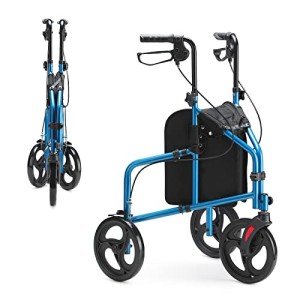As people age or experience mobility challenges, daily tasks can become progressively difficult. A rollator with brakes is a mobility aid created to improve self-reliance and safety for users. These tools not just supply assistance while walking but likewise come equipped with brakes that make sure stability and control. This post explores the functions, benefits, and considerations for selecting a rollator with brakes, together with often asked questions to help prospective users make notified choices.
A rollator is a mobility aid that generally consists of a wheeled frame with handgrips, a seat, and, most significantly, brakes. Created for individuals who require some assistance while walking, rollators supply stability, assistance, and a convenient way to rest when needed.
Utilizing a rollator with brakes provides many advantages, consisting of:
Rollators can be found in numerous designs to accommodate different user requirements. The following prevail types of rollators with brakes:
| Kind of Rollator | Key Features | Best Suited For |
|---|---|---|
| Standard Rollator | Four wheels, fundamental functionality | General users |
| Heavy-Duty Rollator | Reinforced frame, durable materials | Bigger people |
| Compact Rollator | Lightweight, foldable design | Travel and portability |
| Three-Wheel Rollator | Smaller sized turning radius, easy mobility | Restricted spaces |
Picking the ideal rollator needs consideration of several elements. Here are vital elements to keep in mind:
Proper upkeep makes sure durability and ideal efficiency. Follow these standards to keep a rollator in excellent condition:

Q1: Are rollators ideal for outdoor use?A1: Yes
, many rollators are created for both indoor and outdoor use. Those with larger wheels tend to perform much better on uneven surfaces.
Q2: Can rollators fold up for simple storage?A2: Most rollators include a folding function, making them easy to store and transport. Q3: How do I know if a rollator is safe for me?A3: Ensure the weight capacity fulfills your requirements, for use on stairs. For stair navigation, , understanding the different types, functions, and maintenance requirements will ensure they choose the best rollator for their requirements. With appropriate care and use, a rollator can substantially boost one's mobility, contributing to better quality of life and greater liberty in everyday activities.
and adjust the deal with height for proper ergonomics. Consulting a doctor for suggestions is also advisable. Q4: Can I use a rollator with brakes on stairs?A4: Rollators are not designed
individuals ought to look for other approaches of support, like hand rails or stair lifts. Q5: How do I take care of a rollator with brakes?A5: Regular cleaning, inspecting for wear and tear, and inspecting the braking system are essential steps for maintenance. Rollators with brakes represent a vital mobility aid for individuals seeking enhanced self-reliance and safety. As users examine their choices
No Data Found!

